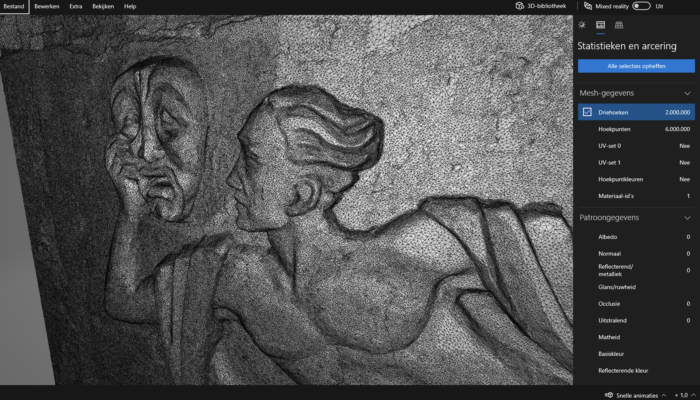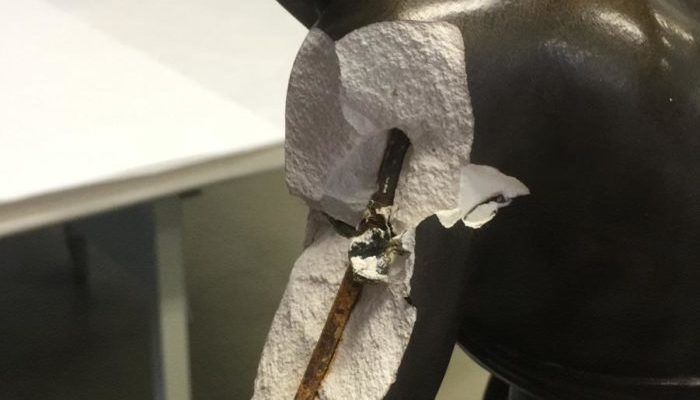Art Conservation has experience in the conservation and restoration of sculptures in indoor and outdoor spaces. In addition to traditional materials such as (natural) stone, bronze or wood, modern works of art such as plastic, polyester, wax, paper and even expanded polystyrene are known to us.
We offer the following services:
Advice | Research | Documentation | 3D imaging techniques | Treatments || Conservation- Restoration | Reconstructions and Replicas (3D scanning) | Installation | Art Handling | Condition reports and survey
Advice
Packing and transporting large three-dimensional objects takes a lot specialized approach, with appropriate techniques and materials. We employ qualified restorers who can advise you on storage, transport, storage and depot organization, maintenance, (damage) inventory and presentation.
Research
Before conservation and / or restoration takes place, a preliminary investigation is carried out. This consists of the description of the various materials, the storage condition, the identification of the damage, its nature and scope, the evaluation of the causes of degradation, the description of the nature and the scope of the necessary treatment.
A visual analysis of a work of art is the first and most important step in the preparations for the restoration of the object. This provides clarity about the condition of the sculpture and suitable treatment can be determined.
We offer microscopic research. Recently we also offer 3D imaging techniques, whereby a 3D scan can be made and ultimately the possibility to perform a 3D print in a material of your choice!
Preservation
Preventive conservation is intervene indirectly , with the aim of slowing down the decay of your sculpture or preventing damage. In order to guarantee the preservation of sculptures, the best conditions must be created. This concerns measures concerning registration, storage, manipulation, packaging, transport and security of collections, disaster planning, display, and so on. Our sister company Art Salvage specializes in this.
Active preventive conservation , also called curative conservation, is above all intervene directly to prevent further disintegration. It is always about minimal and reversible interventions. An important example of this is the maintenance of open-air sculptures. To guarantee their preservation, they can best be cleaned regularly. This can be done in a safe and sustainable way using the laser technique or a steam device, depending on the type of material the sculpture consists of.
Conservation- Restoration
Conservation is the intervene directly on damaged or degraded objects with the aim of improving their readability promote with as much respect as possible for the aesthetic, historical and physical integrity. In consultation with the customer a suitable solution is sought. We conserve for heritage institutions as well as private individuals and offer flexibility regarding large collections, outdoor sculptures or large-format objects.
You can contact us for a variety of treatments:
Cleaning | Consolidate | Adhesion | Application of fillings | Retouching | Manufacture of replicas from cast materials | Desalting | Replacing dives
Documentation is very important. After the treatment, a final report is drawn up in which all examinations and treatments are described in detail and documented using photos. This offers the customer insight into the restoration process. Openness about our activities is an important pillar within our company.
Artists:
Joop Beljon | Barbara Broekman | Wally Elenbaas | Dick Elffers | Peter Erftemeijer | Nick Ervinck | Guido Geelen | John Körmeling | Marcel Kronenburg | Joep van Lieshout | Marjolijn Mandersloot | Loeki Metz | Rob Moonen | Jan Jacobs Mulder | Louis van Roode | Rudi Rooijackers | Jan Spit | Peter Struycken | Jerome Symons | André Volten | Herman de Vries | Marieke Vromans | Tine van de Weyer | Niko de Wit
Code of Ethics: Art Conservation carries out all work according to the ethical guidelines for conservation and restoration of the cultural heritage of the European Confederation of Conservators-Restorers’ Organisations (E.C.C.O.
For all your questions about sculpture restoration, you can contact us, so that we can explore the possibilities together.




